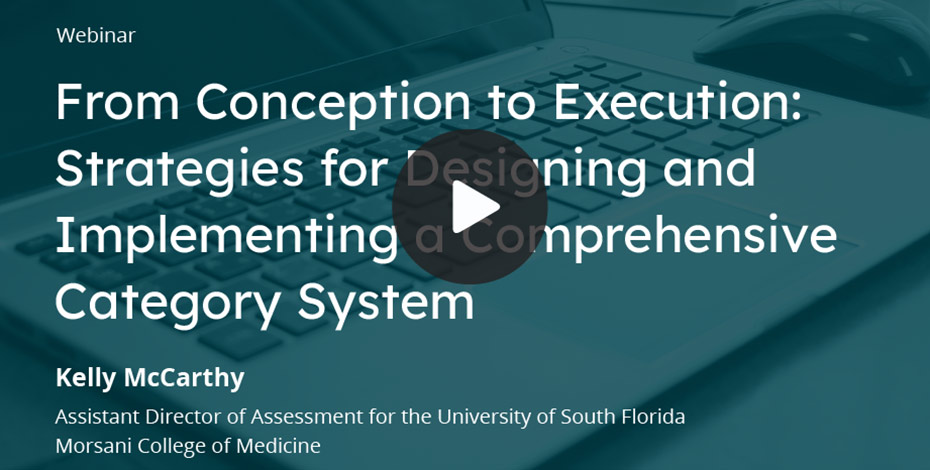There are many assessment solutions out there, but before selecting one, it’s important to ask a few crucial questions: Does the solution offer the features and tools that you need, both at the course level and as an institution? Does it offer the flexibility you need to ensure a reliable and consistent testing experience? Does it have the proper security features to protect exam content? Can it boost efficiency in the assessment process?
There’s a lot to consider, and one of the most important considerations is the amount of actionable data the assessment platform provides.
It’s also important to note that assessments aren’t just for measuring learning outcomes; assessments can also serve as valuable teaching tools — for both students and instructors.
Actionable Data to Benefit All Stakeholders
Many assessment platforms can increase efficiency in the assessment process, but most do not provide the post-exam data that can help students, instructors, programs, and institutions improve.
A complete assessment solution provides reporting and analytics tools. Gathered from secure and reliable exam data, actionable reports allow instructors to provide early remediation to help students focus on the areas in which they’re struggling, which improves retention as well as learning outcomes.
These insights also enable instructors and programs to improve their course materials and teaching methods. Post-exam data can measure current course objectives against accreditation standards, and intuitive reports allow programs to provide the necessary documentation to accrediting bodies.
1. Category Tagging for Focused Reporting
While most LMSs and assessment platforms offer varying levels of data analysis, few offer a category-tagging feature. Category tagging allows exam-makers to tag individual exam items to specific content areas, teaching strategies, accreditation standards, and programmatic goals.
Student Learning Performance
Using category tagging, exam-makers can ensure that students receive actionable, post-exam data to focus their study efforts. When exam items are tagged to specific content areas, students know where they did well and where they struggled, allowing them to focus their studies on the content they found more challenging. A letter grade doesn’t tell the exam-taker what content areas they need to revisit for future assessments, so many students will spend time going over material they have already mastered.
Early and customized remediation, with reports built through category tagging, also increase student retention.
Course & Instruction Performance
Tagging exam items to categories also helps instructors. For example, an exam-maker may tag items to specific teaching methods used throughout a semester. When they receive the exam performance report, they may see that a “flipped classroom” worked well for one content area, but not so well for another. With this information, they can adjust teaching strategies for the areas in which students performed poorly.
Category tagging can also help instructors and curriculum designers find gaps in curricular content. If a majority of exam-takers found certain items more challenging, the instructor might revisit their syllabus and curriculum map to see which areas weren’t covered to the extent needed for successful student outcomes. With this information in mind, they can adjust the curriculum to ensure all desired learning goals are met.
Program Performance
As student performance, course instruction, and curriculum improve through reports built on category tagging, the entire program improves. Category tagging also allows instructors to coordinate their teaching efforts with other instructors and administrators by housing programmatic reports all in one location.
Accreditation Review
Exam-makers and administrators can use category tagging to initiate the accreditation process or maintain accreditation status. The reports from items tagged to accreditation standards provide accreditors with the documentation they need to ensure the program and institution are meeting all standards set by the accrediting body. The reporting function, based on category tagging, eases accreditation visits for all stakeholders.
Psychometric Reporting
Assessments are only as effective as their items, and psychometric analysis ensures fair and valid questions. Most assessment solutions lack this capability, so programs interested in improving exam and item quality need to hire costly psychometricians to analyze their questions.
An assessment platform with built-in psychometric reporting gives programs the insights to improve exam and item quality in-house. Faculty can view metrics such as item difficulty index, discrimination index, and point-biserial to determine whether to adjust scores for specific exams or revise certain exam items that will appear on future assessments.
2. الأمان
For many reasons, a top concern for assessment is security. First, it’s important to know that students have gained proficiency with the concepts covered in the course. This enables them to succeed in subsequent courses and their future careers. Secure exams, and the content therein, ensures that the reports students and instructors receive are accurate.
Not all LMSs and remote exam providers thoroughly encrypt their exam and answer files, meaning exams, answer files, and personal data can be compromised. With encrypted exam files, both students and exam administrators can feel confident in the knowledge that their exam files are secure. ExamSoft protects exam integrity with military-grade, AES 256-bit encryption. Students’ answer files are uploaded to ExamSoft’s cloud-based portal without worries about their exams — or their sensitive personal data — being compromised. And exam administrators know their exams are safe from security breaches of all kinds with this level of encryption.
3. Multiple Question and Assessment Types
Each subject or field requires different types of assessments, which include a variety of question types. But many assessment solutions utilize only a few — multiple choice, true/false, and essay, for example. While there is inherent value in using each of these question types, alone they are not enough to deliver the range of assessments that many programs need.
In medical education, an assessment platform needs to have the ability to test students’ knowledge when presented with real-world situations. And nursing programs need special item types to prepare students for the Next Generation ®NCLEX. Law programs need to be able to evaluate essays without sacrificing objectivity — an essay feature with rubrics-based scoring can do just that.
Students who aren’t familiar with the item types on a high-stakes exam may spend time and mental energy on figuring out the format of the question and not the content. When students are already familiar with the item types, they can focus on what’s important: the content.
Exam Tools and Features for Exam-Takers
Many digital exam platforms lack features that allow customization, which can limit the exam experience for students and leave few options for exam-makers. A more comprehensive solution offers features like calculators, timers, exam navigation options, spreadsheets, and highlighters for exam-taker use. With a complete exam solution, students can flag questions to return to if they feel the need, and they can also review item-level attachments — such as images and documents as well as audio and video files. These features and tools enable exam administrators to deliver the most comprehensive assessments, helping them gain a better picture of student learning.
Choose an All-in-One Assessment Solution
For optimal efficiency, educational programs and institutions need a solution that unites all of these tools and features in one, easy-to-use platform. ExamSoft’s digital assessment solution provides the security, analytics, and flexibility you need to improve the exam experience. And with built-in reporting and analytics, you have the insights you need to improve student learning outcomes, achieve goals for your course and program, and streamline the accreditation process to support the success of your institution.
Contact us to learn how your program can benefit from ExamSoft’s comprehensive solution.







